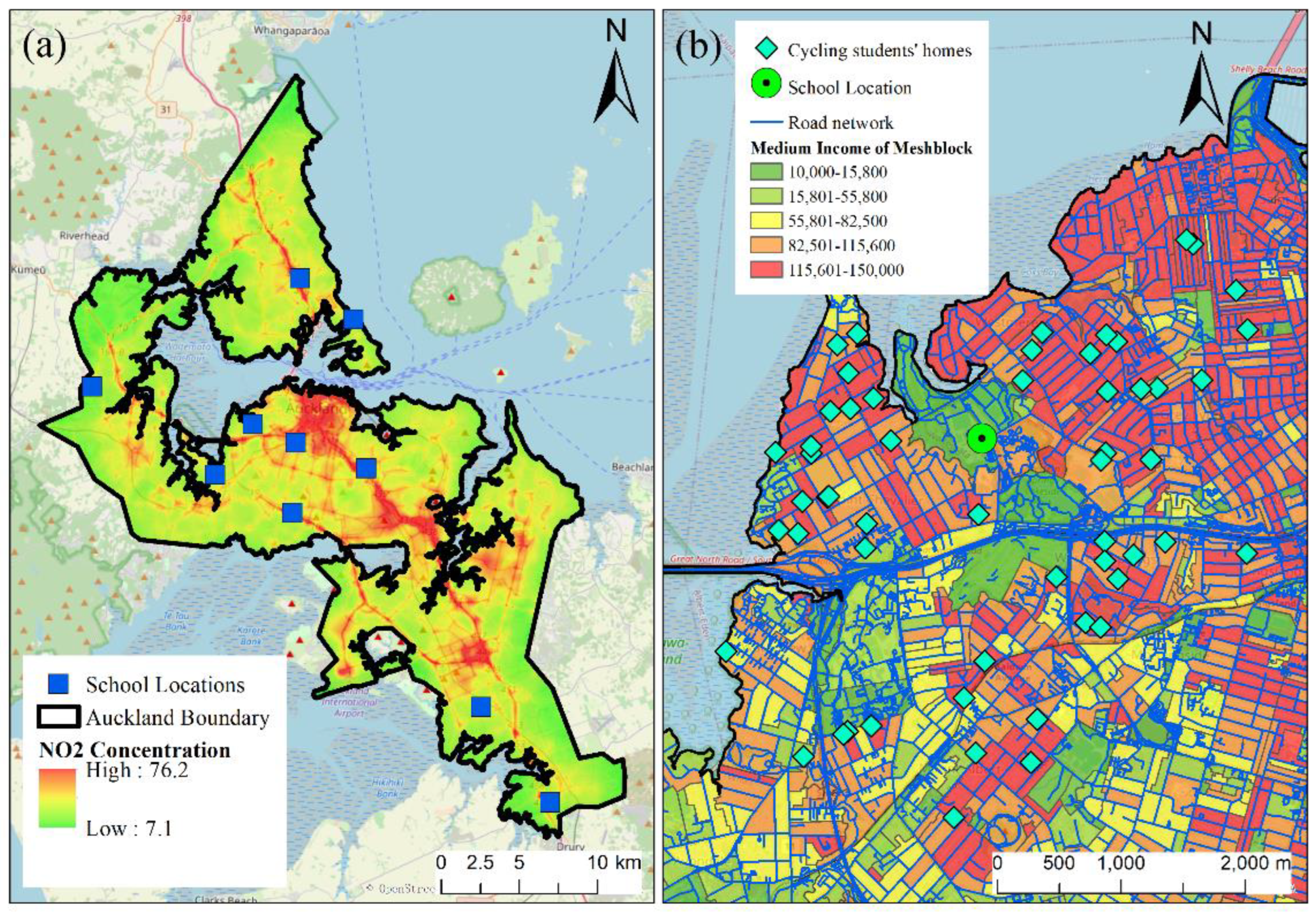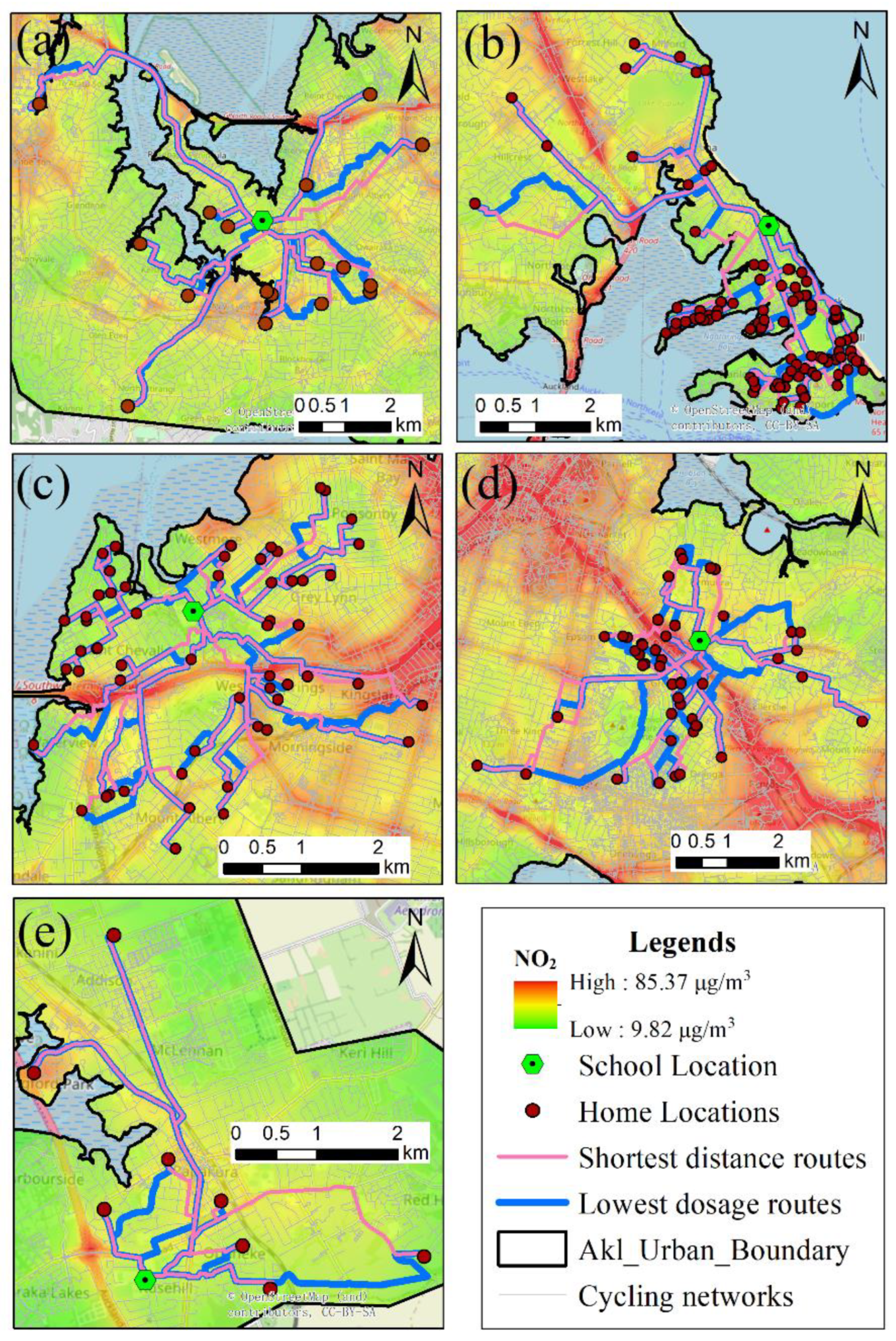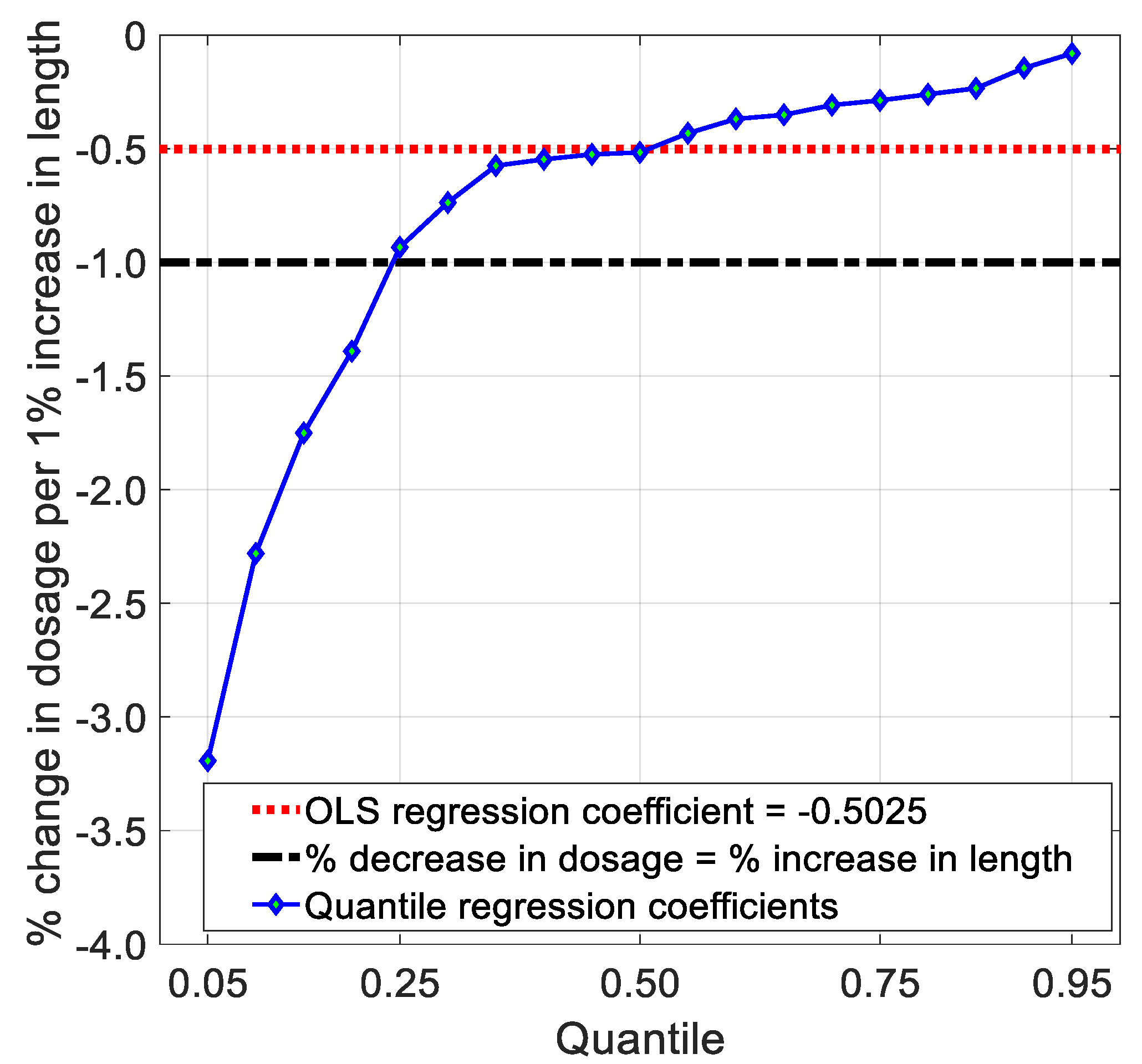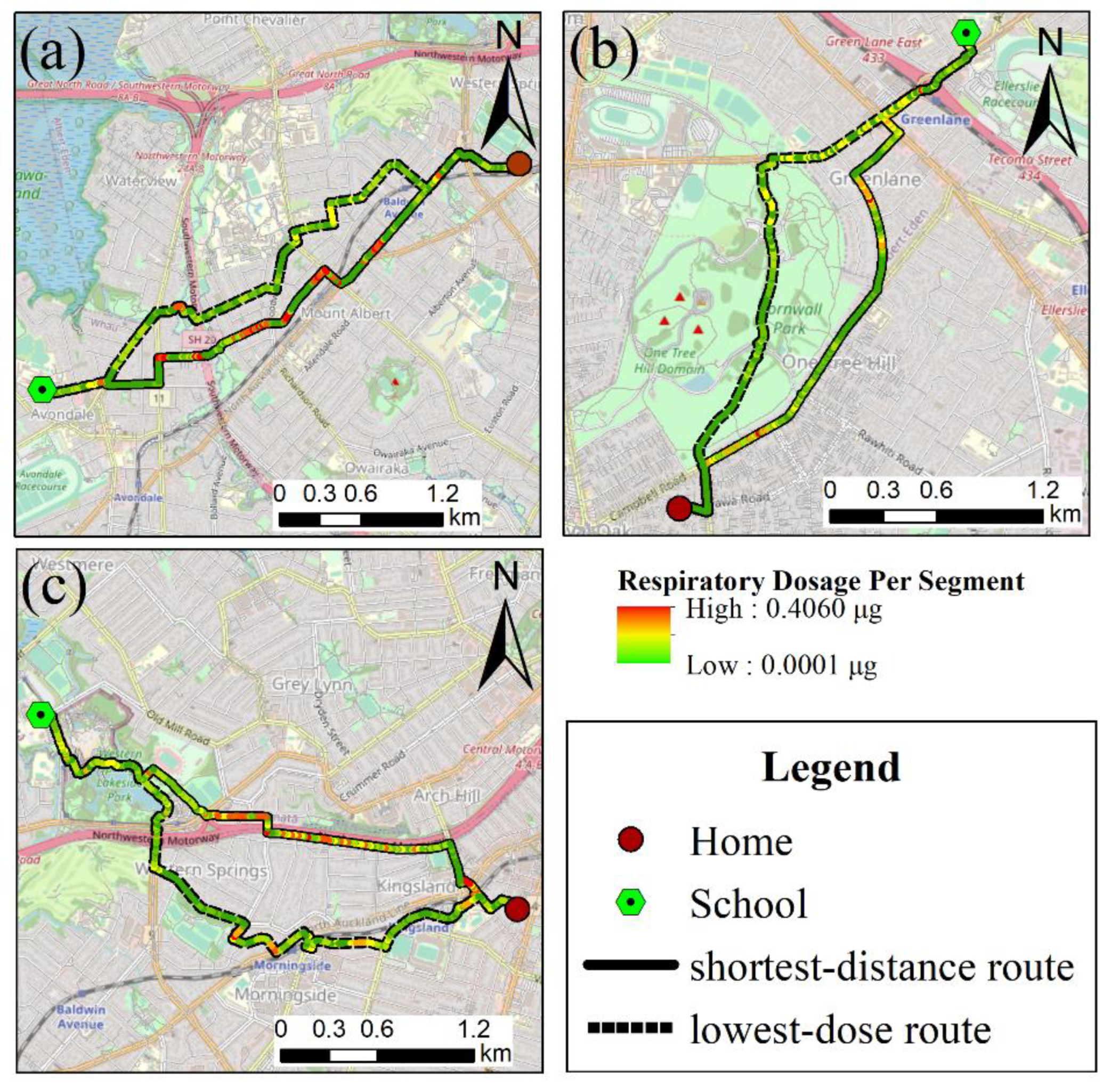A Novel Approach to Estimating the Dose of Ambient Air Pollution during Cycling Commutes from Home to School and Route Optimizations
Abstract
:1. Introduction
2. Materials and Methods
2.1. Study Area and Data Used
2.2. Modeling Ambient NO2 Concentration
2.3. Determine the Cycling Network
2.4. Determine the Terrain-Based Dosage
2.5. Spatial Analysis and Route Generation
2.6. Exposure Justice during Cycling
3. Results and Discussion
3.1. Descriptive Statistics
3.2. Dosage during Cycling Commutes along Different Routes
3.3. Trade-Off between Different Route Choices
3.4. Exposure (In)Justice
3.5. General Discussion
4. Conclusions
Author Contributions
Funding
Institutional Review Board Statement
Informed Consent Statement
Data Availability Statement
Acknowledgments
Conflicts of Interest
References
- Ma, X.; Longley, I.; Gao, J.; Salmond, J. Evaluating the Effect of Ambient Concentrations, Route Choices, and Environmental (in) Justice on Students’ Dose of Ambient NO2 While Walking to School at Population Scales. Environ. Sci. Technol. 2020, 54, 12908–12919. [Google Scholar] [CrossRef]
- Dominski, F.H.; Branco, J.H.L.; Buonanno, G.; Stabile, L.; da Silva, M.G.; Andrade, A. Effects of Air Pollution on Health: A Mapping Review of Systematic Reviews and Meta-analyses. Environ. Res. 2021, 201, 111487. [Google Scholar] [CrossRef]
- Alvarez-Pedrerol, M.; Rivas, I.; López-Vicente, M.; Suades-González, E.; Donaire-Gonzalez, D.; Cirach, M.; de Castro, M.; Esnaola, M.; Basagaña, X.; Dadvand, P.; et al. Impact of Commuting Exposure to Traffic-related Air Pollution on Cognitive Development in Children Walking to School. Environ. Pollut. 2017, 231, 837–844. [Google Scholar] [CrossRef] [Green Version]
- Engström, E.; Forsberg, B. Health Impacts of Active Commuters’ Exposure to Traffic-related Air Pollution in Stockholm, Sweden. J. Transp. Health 2019, 14, 100601. [Google Scholar] [CrossRef]
- Rivas, I.; Donaire-Gonzalez, D.; Bouso, L.; Esnaola, M.; Pandolfi, M.; De Castro, M.; Viana, M.; Àlvarez-Pedrerol, M.; Nieuwenhuijsen, M.; Alastuey, A.; et al. Spatiotemporally Resolved Black Carbon Concentration, Schoolchildren’s Exposure and Dose in Barcelona. Indoor Air. 2016, 26, 391–402. [Google Scholar] [CrossRef] [Green Version]
- Buonanno, G.; Giovinco, G.; Morawska, L.; Stabile, L. Tracheobronchial and Alveolar Dose of Submicrometer Particles for Different Population Age Groups in Italy. Atmos. Environ. 2011, 45, 6216–6224. [Google Scholar] [CrossRef] [Green Version]
- Paunescu, A.C.; Attoui, M.; Bouallala, S.; Sunyer, J.; Momas, I. Personal Measurement of Exposure to Black Carbon and Ultrafine Particles in Schoolchildren from PARIS Cohort (Paris, France). Indoor Air. 2017, 27, 766–779. [Google Scholar] [CrossRef]
- Ma, X.; Longley, I.; Gao, J.; Salmond, J. Assessing Schoolchildren’s Exposure to Air Pollution during the Daily Commute-A Systematic Review. Sci. Total Environ. 2020, 737, 140389. [Google Scholar] [CrossRef]
- Pujol, J.; Martínez-Vilavella, G.; Macià, D.; Fenoll, R.; Alvarez-Pedrerol, M.; Rivas, I.; Forns, J.; Blanco-Hinojo, L.; Capellades, J.; Querol, X.; et al. Traffic Pollution Exposure Is Associated with Altered Brain Connectivity in School Children. Neuroimage 2016, 129, 175–184. [Google Scholar] [CrossRef] [PubMed] [Green Version]
- Tudor-Locke, C.; Ainsworth, B.E.; Popkin, B.M. Active Commuting to School. Sports Med. 2001, 31, 309–313. [Google Scholar] [CrossRef] [PubMed]
- Gilliland, J.; Maltby, M.; Xu, X.; Luginaah, I.; Loebach, J.; Shah, T. Is Active Travel a Breath of Fresh Air? Examining Children’s Exposure to Air Pollution during The School Commute. Spat. Spatiotemporal Epidemiol. 2019, 29, 51–57. [Google Scholar] [CrossRef] [PubMed]
- Carreras, H.; Ehrnsperger, L.; Klemm, O.; Paas, B. Cyclists’ Exposure to Air Pollution: In Situ Evaluation with a Cargo Bike Platform. Environ. Monit. Assess. 2020, 192, 470. [Google Scholar] [CrossRef] [PubMed]
- Agarwal, A.; Kaddoura, I. On-road Air Pollution Exposure to Cyclists in an Agent-Based Simulation Framework. Period. Polytech. Transp. Eng. 2020, 48, 117–125. [Google Scholar] [CrossRef]
- Adams, M.D.; Yiannakoulias, N.; Kanaroglou, P.S. Air Pollution Exposure: An Activity Pattern Approach for Active Transportation. Atmos. Environ. 2016, 140, 52–59. [Google Scholar] [CrossRef]
- Ma, X.; Longley, I.; Gao, J.; Kachhara, A.; Salmond, J. A Site-optimised Multi-scale GIS Based Land Use Regression Model for Simulating Local Scale Patterns in Air Pollution. Sci. Total Environ. 2019, 685, 134–149. [Google Scholar] [PubMed]
- NZ MfE. Emissions Inventories for CO, NOx, SO2, Ozone, Benzene and Benzo(a)pyrene in New Zealand. Available online: https://environment.govt.nz/publications/emission-inventories-for-co-nox-so2-ozone-benzene-and-benzoapyrene-in-new-zealand/ (accessed on 21 June 2022).
- Weissert, L.F.; Salmond, J.A.; Miskell, G.; Alavi-Shoshtari, M.; Williams, D.E. Development of a Microscale Land Use Regression Model for Predicting NO2 Concentrations at a Heavy Trafficked Suburban Area in Auckland, NZ. Sci. Total Environ. 2018, 619–620, 112–119. [Google Scholar] [CrossRef]
- Miskell, G.; Salmond, J.; Longley, I.; Dirks, K.N. A Novel Approach in Quantifying the Effect of Urban Design Features On Local-Scale Air Pollution in Central Urban Areas. Environ. Sci. Technol. 2015, 49, 9004–9011. [Google Scholar] [CrossRef]
- Beelen, R.; Hoek, G.; Vienneau, D.; Eeftens, M.; Dimakopoulou, K.; Pedeli, X.; Tsai, M.Y.; Künzli, N.; Schikowski, T.; Marcon, A.; et al. Development of NO2 and NOx Land Use Regression Models for Estimating Air Pollution Exposure in 36 Study Areas in Europe–The ESCAPE Project. Atmos. Environ. 2013, 72, 10–23. [Google Scholar] [CrossRef]
- Morton, T. Travelwise to School: Delivering School Travel Plans in The New Zealand Environment. In Proceedings of the Australasian Transport Research Forum (ATRF), Sydney, Australia, 28–30 September 2005. [Google Scholar]
- Chieng, M.; Lai, H.; Woodward, A. How Dangerous Is Cycling in New Zealand? J. Transp. Health. 2017, 6, 23–28. [Google Scholar] [CrossRef]
- Mirza, L.; Cheung, A.K.; Moradi, S. Understanding Factors Influencing Choices of Cyclists and Potential Cyclists: A Case Study at The University of Auckland. Road Transp. Res. 2014, 23, 37–51. [Google Scholar]
- Price, M. Slopes, Sharp Turns, and Speed: Refining Emergency Response Networks to Accommodate Steep Slopes and Turn Rules. Hands On ArcUser Spring 2008, 11, 50–57. [Google Scholar]
- Parkin, J.; Rotheram, J. Design Speeds and Acceleration Characteristics of Bicycle Traffic for Use in Planning, Design and Appraisal. Transport Pol. 2010, 17, 335–341. [Google Scholar] [CrossRef]
- Liu, L.; Suzuki, T. Quantifying E-Bike Applicability by Comparing Travel Time and Physical Energy Expenditure: A Case Study of Japanese Cities. J. Transp. Health. 2019, 13, 150–163. [Google Scholar] [CrossRef]
- Zoladz, J.A.; Rademaker, A.C.H.J.; Sargeant, A.J. Non-Linear Relationship Between O2 Uptake and Power Output at High Intensities of Exercise in Humans. J. Physiol. 1995, 488, 211–217. [Google Scholar] [CrossRef] [PubMed] [Green Version]
- US EPA. Metabolically Derived Human Ventilation Rates: A Revised Approach Based upon Oxygen Consumption Rates. Available online: https://ordspub.epa.gov/ords/eims/eimscomm.getfile?p_download_id=490080 (accessed on 21 July 2022).
- Hofman, J.; Samson, R.; Joosen, S.; Blust, R.; Lenaerts, S. Cyclist Exposure to Black Carbon, Ultrafine Particles and Heavy Metals: An Experimental Study Along Two Commuting Routes Near Antwerp, Belgium. Environ. Res. 2018, 164, 530–538. [Google Scholar] [CrossRef] [PubMed]
- Adams, M.; Bennet, S.; Yiannakoulias, N.; Kanaroglou, P. Does Walking or Cycling Provide the Lowest PM2.5 Air Pollution Dose During the Trip from Home to School for Children? In Proceedings of the Canadian Transportation Research Forum, Windsor, ON, Canada, 1–4 June 2014. [Google Scholar]
- Cakmak, S.; Hebbern, C.; Cakmak, J.D.; Vanos, J. The Modifying Effect of Socioeconomic Status on the Relationship Between Traffic, Air Pollution and Respiratory Health in Elementary Schoolchildren. J. Environ. Manage. 2016, 177, 1–8. [Google Scholar] [CrossRef] [Green Version]
- Grineski, S.E.; Collins, T.W. Geographic and Social Disparities in Exposure to Air Neurotoxicants at US Public Schools. Environ. Res. 2018, 161, 580–587. [Google Scholar] [CrossRef]
- Jephcote, C.; Chen, H. Environmental Injustices of Children’s Exposure to Air Pollution from Road-Transport Within the Model British Multicultural City of Leicester: 2000–2009. Sci. Total Environ. 2012, 414, 140–151. [Google Scholar] [CrossRef]
- Chakraborty, J.; Zandbergen, P.A. Children at Risk: Measuring Racial/Ethnic Disparities in Potential Exposure to Air Pollution at School and Home. J. Epidemiol. Commun. Health 2007, 61, 1074–1079. [Google Scholar] [CrossRef]





| No. | School Name | Type of School | Location | No. of Cycling Students |
|---|---|---|---|---|
| 1 | Western Spring College | High School | Central Auckland | 58 |
| 2 | Mount Roskill Grammar School | High School | Central Auckland | 20 |
| 3 | Rosehill College | High School | South Auckland | 8 |
| 4 | Westlake Boys High School | High School | North Auckland | 31 |
| 5 | Takapuna Grammar School | High School | North Auckland | 107 |
| 6 | Massey High School | High School | West Auckland | 16 |
| 7 | Avondale College | High School | West Auckland | 19 |
| 8 | Kōwhai Intermediate School | Intermediate School | Central Auckland | 19 |
| 9 | Remuera Intermediate School | Intermediate School | Central Auckland | 47 |
| 10 | Manurewa Intermediate School | Intermediate School | South Auckland | 7 |
| Route Types | Statistics | Length (m) | Dosage (μg) |
|---|---|---|---|
| All shortest-distance routes | Max | 8814.40 | 13.38 |
| Min | 707.60 | 0.79 | |
| Mean | 2666.88 | 4.08 | |
| Std | 1162.08 | 2.04 | |
| All lowest-dose routes | Max | 8865.34 | 13.25 |
| Min | 707.60 | 0.79 | |
| Mean | 2837.17 | 3.82 | |
| Std | 1272.36 | 1.89 | |
| Alternative lowest-dose routes (those differ from their shortest-distance routes) | Max | 8865.34 | 13.25 |
| Min | 824.33 | 1.13 | |
| Mean | 3072.63 | 4.05 | |
| Std | 1258.39 | 1.91 |
| No. | School Name | No. of Students | No. of ALDRs | Proportion |
|---|---|---|---|---|
| 1 | Western Spring College | 58 | 45 | 77.59% |
| 2 | Mount Roskill Grammar School | 20 | 15 | 75.00% |
| 3 | Rosehill College | 8 | 6 | 75.00% |
| 4 | Westlake Boys High School | 31 | 22 | 70.97% |
| 5 | Takapuna Grammar School | 107 | 87 | 81.31% |
| 6 | Massey High School | 16 | 10 | 62.50% |
| 7 | Avondale College | 19 | 13 | 68.42% |
| 8 | Kōwhai Intermediate School | 19 | 17 | 89.47% |
| 9 | Remuera Intermediate School | 47 | 38 | 80.85% |
| 10 | Manurewa Intermediate School | 7 | 2 | 28.57% |
| Sum | 332 | 255 | 76.81% | |
| Income Level | Income Ranges | Population Proportion | High Exposure Proportion |
|---|---|---|---|
| Low income | 10–80 K | 24.10% | 27.11% |
| High income | 80–150 K | 75.90% | 72.89% |
Publisher’s Note: MDPI stays neutral with regard to jurisdictional claims in published maps and institutional affiliations. |
© 2022 by the authors. Licensee MDPI, Basel, Switzerland. This article is an open access article distributed under the terms and conditions of the Creative Commons Attribution (CC BY) license (https://creativecommons.org/licenses/by/4.0/).
Share and Cite
Gao, Y.; Ma, X.; Xiao, S. A Novel Approach to Estimating the Dose of Ambient Air Pollution during Cycling Commutes from Home to School and Route Optimizations. Atmosphere 2022, 13, 1612. https://doi.org/10.3390/atmos13101612
Gao Y, Ma X, Xiao S. A Novel Approach to Estimating the Dose of Ambient Air Pollution during Cycling Commutes from Home to School and Route Optimizations. Atmosphere. 2022; 13(10):1612. https://doi.org/10.3390/atmos13101612
Chicago/Turabian StyleGao, Yue (Jason), Xuying Ma, and Shun Xiao. 2022. "A Novel Approach to Estimating the Dose of Ambient Air Pollution during Cycling Commutes from Home to School and Route Optimizations" Atmosphere 13, no. 10: 1612. https://doi.org/10.3390/atmos13101612





